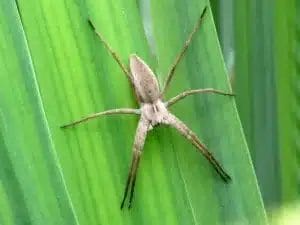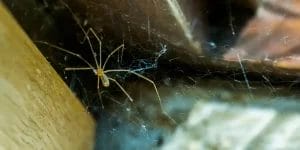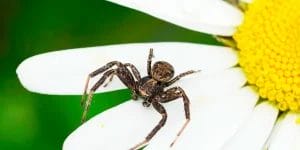Most Common Spiders Found in San Antonio Texas
When you call Texas home, there are plenty of perks – but unfortunately, some creepy crawlers can come along with the territory. With various species ranging from common house spiders to black widows inhabiting both indoors and outdoors, it’s important for those living in the Lone Star State to be aware of what they may have lurking nearby. For most property owners without an insect-identifying background though, distinguishing which type is present can prove challenging.
Looking to explore the eight-legged critters that inhabit Texas? Let’s take a look at what kinds of spiders are most often seen in the Lone Star State.
Grass Spiders
Grass spiders, also known as funnel spiders, are common spiders you’ll see in Texas. On average, they measure roughly half an inch. These spiders create flat webs with a funnel-like shape at one end where they hide and wait for food. The web is usually situated between grasses or other vegetation, hence its name.
The spiders’ color can vary from light brown to dark grey with stripes on the abdomen and legs. They feed on a variety of insects including flies, moths, beetles, and grasshoppers which they capture in their webs. Unlike their orb-weaver cousins, they don’t spin intricate snares. Instead, they rely on vibrations to locate prey that has become ensnared in their webs.
Grass spiders are not aggressive and they do not bite unless provoked or threatened, so it’s best to leave them alone if you spot one in your garden or yard. If spiders make you uncomfortable, the best way to get rid of grass spiders is to remove their webs and habitats. Avoid using insecticides as these can have adverse effects on other beneficial insects in your garden. Regularly trimming tall grasses and keeping debris away from your home can also help reduce the number of spiders around your property.
Common House Spider
Common house spiders found in and around homes throughout Texas include the American House Spider, Cellar Spider, and Varied Carpet Spider.
American House Spiders usually have a yellowish-brown coloration with dark brown stripes and spots on their backs. Cellar spiders have long legs that are usually grayish-brown in color and may have some orange or yellow coloring as well. And the Varied Carpet spiders often have light to dark brown bodies, depending on the individual spider.
These spiders often make their webs near windows, doorframes, light fixtures, and other corners inside homes.
Common house spiders typically do not bite humans when they enter homes, but they can become aggressive if disturbed or threatened. Generally, these spiders are not dangerous; they have very small fangs that cannot pierce human skin. However, some people may experience an allergic reaction when bitten by them
To keep spiders from invading your home, it is important to eliminate potential food sources such as insects and other spiders near your home. Additionally, regular cleaning such as vacuuming cracks and crevices where spiders tend to hide is recommended for effective control of these pests.
The Longbodied Cellar Spider
The Longbodied Cellar Spider, also known as the Daddy-Longlegs spider, is a species of spider that is found throughout the United States and Canada. In Texas, they have become particularly abundant in recent years.
These spiders look quite different from other spiders due to their very long legs compared to their small body size. They typically range between a half inch to an inch in size and have thin, segmented bodies that can be various shades of brown or gray depending on the species. Their long legs are usually yellowish and covered in short hairs.
Like most spiders, these spiders generally feed on other insects and spiders caught in webs spun by themselves or their relatives. Although they may not build elaborate webs like some other spiders, their webs are often found in dark, damp places like cellars and basements where they can be most easily seen.
These spiders are harmless to humans and animals, but they can be annoying by getting into houses and looking for food or shelter. While no one likes seeing spiders inside the home, it is important to remember that spiders play an essential role in controlling insect populations, including some of our worst pests such as mosquitoes and flies.
If you want to keep these spiders out of your house, make sure that all entrances and windows are properly sealed and kept free from any debris or cobwebs.
Orb Weavers
Orb weaver spiders are a common sight in Texas. These arachnids spin intricate webs to capture their prey and can be found in gardens, fields, forests, and other habitats throughout the state. While some of these spiders may look intimidating due to their size and bold colors, they are generally harmless to humans and beneficial for controlling insect populations.
Most orb weavers belong to the Araneidae family, and several species call Texas home. One of the most recognizable is the black-and-yellow Argiope spider, which has distinctive yellow and black stripes down its body. Other members of this group include the garden spider, the banded garden spider, and the barn spider.
In Texas, Orb weavers typically spin their webs in trees, shrubs, and open fields during the summer months. When spiders are not actively creating or repairing their webs, they can be found resting on nearby foliage or hiding in the underbrush. At night, spiders are most active and can be seen darting around to capture any insects that fly into their web. In winter, spiders usually take shelter in sheltered places like inside homes or barns until warmer weather returns.
Woodlouse Hunter
Unlike the typical dark brown or black coloring of other spiders, woodlouse spiders boast an eye-catching red or orange body coupled with a grayish-white abdomen and lengthy thin legs – giving them great agility in finding shelters. No more than half an inch long, they stand out among their 8-eyed peers by having only 6 eyes!
They generally live in moist environments such as under rocks, logs, and other debris where they can find their favorite prey – woodlice. Woodlouse Hunter spiders use their powerful jaws to kill their prey before wrapping it up in silk and feeding upon it later. Though these spiders can bite if provoked, they pose no real threat to humans. If you come across one of these spiders in Texas, do not be alarmed! Just admire it from a distance.
Removing Woodlouse Hunter spiders from your home is easy – simply use a vacuum or broom. If you prefer to opt for insecticides, make sure that the products used are specifically designed to target spiders so that other beneficial animals and insects in the vicinity stay unharmed. Don’t let pests take over your home; call a reliable pest control service for assistance.
Crab Spiders
Texas Crab spiders can be found scurrying across the Lone Star State in open pastures, meadows, and wooded regions. These arachnids are a species of spider that is unique to Texas!
These spiders range in size from 5-15 mm in length and have broad abdomens with distinctive markings that differ between species. They can be recognized by their four long front legs which they use to ‘crab-walk’ sidewards as well as their two back pairs of legs used for jumping and running.
The Texas Crab spiders feed on a variety of insects including grasshoppers, flies, moths, and beetles which they hunt both day and night depending on the species. Unlike most spiders that construct webs to catch prey, the Texas Crab spiders actively stalk their prey and pounce on it when within reach.
In addition to their predatory habits, Texas Crab spiders are excellent climbers due to their spiny legs that can attach to branches and other surfaces. They often seek refuge from predators in between leaves and vegetation, making them difficult to spot.
The Gray Wall Jumping Spider
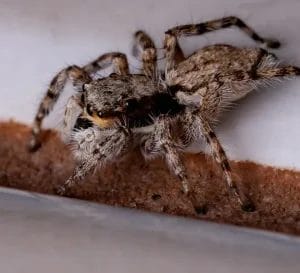
The spiders generally live near walls or other structures where they can hide during the day. At night, they come out to hunt small insects, such as flies and moths. They use their eyesight to locate prey before pouncing on them with their powerful hind legs. They also have excellent jumping abilities, which helps them catch their meals quickly!
These spiders are renowned for their resilience, as they can thrive in extreme temperatures and arid environments. Even places with limited water sources or precipitation will be home to them.
Carolina Wolf Spider
The Carolina Wolf Spider is a species of spider native to Texas and other parts of the United States. These spiders are typically found in moist, humid areas such as wooded forests, grasslands, and open fields near bodies of water.
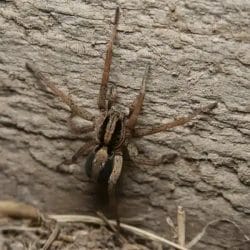
The female spiders construct a cocoon-like structure that they attach to their spinnerets while they carry and protect their egg sacs. The spiders will remain with the eggs until they hatch before dispersing.
Though intimidating to look at, the Carolina Wolf Spider is not considered dangerous to humans. They are unlikely to bite unless provoked and their venom is harmless to people. That being said, it’s best to leave spiders alone if encountered in the wild or your home. These spiders can be found throughout Texas and other parts of the United States typically during springtime when outdoor temperatures become warmer.
Brown Widows
The Brown Widow Spider is an intimidating-sounding creature that can be found in Texas, as well as other tropical parts of the world. This species typically grows up to 1/3 inch in body length and has an eye-catching yellow-orange hourglass design on its abdomen. Its body is mostly brownish with gray-mottled legs for added contrast.
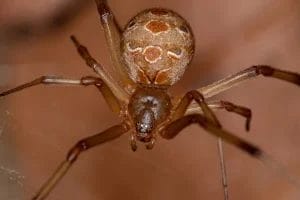
They do have venom that can cause swelling, itching, and redness when bitten – but usually only if the spider is disturbed or threatened. It is rare for these spiders to bite humans and they are not considered dangerous unless provoked. If you are bitten by one of these spiders, it is best to seek medical attention immediately.
Texas residents should take precautions against encountering Brown Widows by regularly checking outdoor spaces for webs and monitoring any spiders seen on their property. Keeping potential nesting sites clear such as clutter, woodpiles, and junk piles help limit the spiders’ access points and reduce infestation risks.
Since the Brown Widow spiders tend to be more reclusive than their cousins, the Black Widow spiders, they can be harder to detect. It is recommended that if spiders are spotted in an area, a professional should be contacted to properly identify and remove them.
Black Widows

Black Widows spiders generally make their webs in dark places such as basements or other areas that protect from predators and weather elements. Spiders rely on these webs to capture food sources and protect themselves from harm. Black Widow spiders feed mainly on insects, but can also consume small animals like lizards occasionally.
These spiders pose a potential threat to humans if they are encountered while outdoors as they possess potent venom which can cause severe pain and illness if one is bitten. It is best to exercise caution when navigating outdoor spaces in Texas, as Black Widow spiders may be present.
If you happen to notice Black Widow spiders around your home, it is highly recommended that you contact a pest control company as soon as possible.
Brown Recluse Spider
Brown recluse spiders are among the most feared spiders in Texas. These spiders can be identified by their violin-shaped pattern on their backs and their yellowish-brown color. Brown recluse spiders are venomous and, while very rarely fatal to humans, they can cause serious injury if bitten.

Brown recluse spiders are most active during the night and early morning, weaving their webs in hard-to-reach places, like corners, and under furniture. This offers them an alluring spot to ensnare unsuspecting prey. Therefore it is essential to be mindful of these nocturnal dwellers when visiting dark spaces around your home or office.
Brown recluse spiders are incredibly venomous and it’s essential to take the necessary safety measures if you happen to spot one. Keep your home tidy, swept up, and free of any arachnids. Use gloves whenever working in or around gardens/yards outdoors, and double-check all items that have been outside before bringing them indoors. If bitten by a brown recluse spider you must seek medical assistance immediately as their bites can lead to severe injury!
If you think you’ve seen a brown recluse spider in your area, it is important to contact a pest control professional for help. Pest control experts can identify spiders and determine the best way to get rid of them. They can also provide advice on how to keep spiders away from your home, such as sealing up entry points and eliminating clutter where spiders might hide.
Tips for keeping spiders out of your home.
- Spiders are more likely to enter your home in the fall when they are looking for a warm place to spend the winter. To keep spiders out, make sure to seal any cracks or openings around your home, such as those around doors and windows.
- Spiders are attracted to homes that have a lot of insects. Try to reduce the number of insects in your home by keeping food sealed and eliminating sources of water that insects may be attracted to.
- Spiders are also attracted to homes that offer a lot of hiding places. To reduce the number of hiding places for spiders, declutter your home and get rid of any items that are not being used.
- Remember, most spiders are not dangerous and pose no threat to humans. Many spiders help to control the population of other pests in your home. So if you do see a spider in your home, there is no need to panic!
- If you are still concerned about spiders in your home, contact a professional pest control company for assistance.
When you’re in the great state of Texas, it’s not uncommon to catch a glimpse of spiders. With knowledge of the kinds typically seen in this region, you’ll be able to decide which ones are harmless and which should steer clear from. To ensure your safety and keep these pests away from your home, don’t hesitate to reach out to an experienced pest control expert for assistance!

